![]()
![]()
![]()
Use LEFT and RIGHT arrow keys to navigate between flashcards;
Use UP and DOWN arrow keys to flip the card;
H to show hint;
A reads text to speech;
49 Cards in this Set
- Front
- Back
|
There are 3 states of matter: |
Solid, Liquid and Gas |
|
|
The particles are arranged differently in each state of matter... They also have... |
Different types of movement |
|
|
Solids, Liquids and Gases can be changed into one another by.... |
Changing the amount of energy that the particles have |
|
|
Solid |
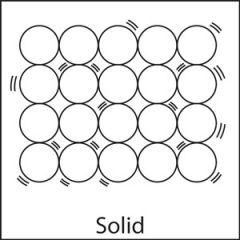
Close together and touching one another, Regular arrangement, Vibrate about fixed positions, forces between particles stronger than in the liquid. |
|
|
Liquid |
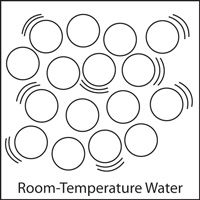
Close together and touching one another, irregular arrangement, Move around and slide past one another, forces between particles not as strong as in the solid. |
|
|
Gas |
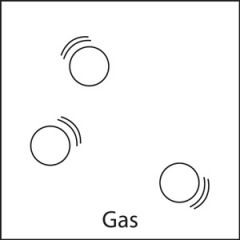
Far apart, irregular arrangement, Move freely and constantly collide with each other, Non-existent forces between particles |
|
|
Solid to liquid - (heat the solid until it melts) |
The particles gain kinetic energy and vibrate faster and faster. This allows the particles to overcome the forces of attraction that hold them together in the solid. The regular pattern is broken down and the particles can now slide past one another. |
|
|
Liquid to Solid - (Cool the liquid until it freezes) |
The particles lose kinetic energy and this allows the forces of attraction between the particles to hold them together. The particles arrange themselves into a regular pattern and are no longer able to slide past one another. |
|
|
Liquid to Gas - (Heat the liquid until it boils) |
The particles gain kinetic energy and move further apart. Eventually the forces of attraction between the particles are completely broken and they are able to escape from the liquid. |
|
|
Gas to Liquid - (Cool the gas until it condenses) |
The particles lose kinetic energy and this allows the forces of attraction to bring the particles closer together. The particles eventually clump together to form a liquid. |
|
|
Solid to Gas - (Heat the solid until it sublimes) |
The particles gain kinetic energy an vibrate faster and faster. Eventually the forces of attraction between the particles are completely broken and they are able to escape from the solid. |
|
|
Diffusion |
The spreading out of particles in a gas or liquid |
|
|
You can show diffusion in gases easily by... |
Using a gas jar, lower containing brown bromine gas and top containing normal air, over time bromine diffuses upwards making both jars uniformly brown. You could also use hydrogen and air except that to test you would have to do the squeaky pop test. You will find that the hydrogen can be found in both jars. |
|
|
Showing that particles in different gases travel at different speeds: |

Light particles are faster than heavier ones. Ammonia went farther because it is lighter than the HCL |
|
|
Diffusion in liquids and showing that the particles are very small... |
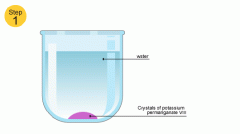
Potassium manganate (VII) |
|
|
Atomic Structure: |
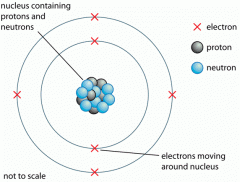
Protons: Rel Charge- +1 Rel Mass - 1 Neutrons: Rel Charge - 0 Rekk Mass: 1 Electrons: Rel Charge - -1 Rel Mass: 1/1836 |
|
|
Atomic Number = |
Number of protons in the nucleus of an atom of an element |
|
|
Mass Number = |
Number of protons + number of neutrons in the nucleus of an atom of an element |
|
|
Iron Fillings |
Element Grey Powder Attracted to magnet Reacts with HCL to form hydrogen gas |
|
|
Sulfur |
Element Yellow Powder Not attracted to magnet Does not react with HCL |
|
|
Iron + Sulfur |
Mixture Mixture of grey and yellow powder Grey powder (Iron) attracted to magnet, Yellow powder not attracted to magnet Grey powder reacts (WITH HCL) to form Hydrogen Gas (H2) Yellow powder doesn't react (WITH HCL) |
|
|
Iron (II) sulfide |
Compound Dark grey solid Not attracted to magnet Reacts with HCL to form hydrogen sulfide (H2S) |
|
|
Filtration |
To separate an undissolved solid from a mixture of the solid and liquid/solution |
|
|
Evaporation |
To separate a dissolved solid from a solution, when the solid has similar solubility in both cold and hot solvent ( e.g sodium chloride from a solution of sodium chloride in water) |
|
|
Crystallisation |
To separate a dissolved solid from a solution, when the solid is much more soluble in hot solvent than in cold |
|
|
Simple distillation |
To separate a liquid from a solution |
|
|
Fractional disstilation |
To separate two or more liquids that are miscible with one another |
|
|
Paper chromatogrpahy |
To separate substances that have different solubilities in a given solvent |
|
|
Isotopes |
When atoms have the same atomic number but different mass numbers |
|
|
The arrangement of electrons into shells for an atom is known as its.... |
Electron Configuration |
|
|
The isotopes of magnesium and their percentage abundances are: Magnesium - 24 78.6%; Magnesium - 25 10.1; Magnesium - 26 11.3% |
Total mass of 100 atoms = (78.6 X 24) + (25 X 10.1) + (11.3 X 25) =2432.7 2432.7/100 = 24.327 = Mean mass of one atom |
|
|
Mole |
A measure of the amount of substance |
|
|
Mass of substance (in grams) = |
Amount X Mr (relative mass) |
|
|
Amount of moles = |
Mass of substance in grams / Mr (relative mass) |
|
|
Volume of gas (in dm3) = |
Amount X 24 |
|
|
Amount of gas (in moles) = |
Volume of gas (in dm3) / 24 or Volume of gas (in cm3) /24000 |
|
|
Volume of gas (in cm3) |
Amount X 24000 |
|
|
Amount of dissolved substance (in mol) |
Volume of solution (in cm3) X concentration of solution (in mol/dm3) ---------------------------------------------------------------------- 1000 |
|
|
Ionic bonding |
Where there has been a transfer of electrons from one atom to another to produces ions. |
|
|
Ionic lattice |
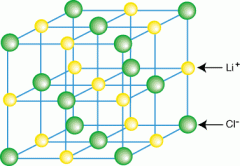
|
|
|
Ionic bond |
The electrostatic force of attraction between the oppositely charged ions |
|
|
The structure of an ionic compound e.g sodium chloride is described as... |
Giant ionic |
|
|
A bond in which electrons are shared between atoms is... |
Covalent bonding |
|
|
The none bonding electrons on the outer level are sometimes called... |
Lone pairs |
|
|
A positive ion is called a.... |
Cation |
|
|
A negative ion is called an... |
Anion |
|
|
Simple molecular... |
Covalent bond consisting of individual molecules |
|
|
Diatomic means... |
Two atoms |
|
|
The attraction between the positive ions and the delocalised electrons is know as a... |
Metallic bond |

